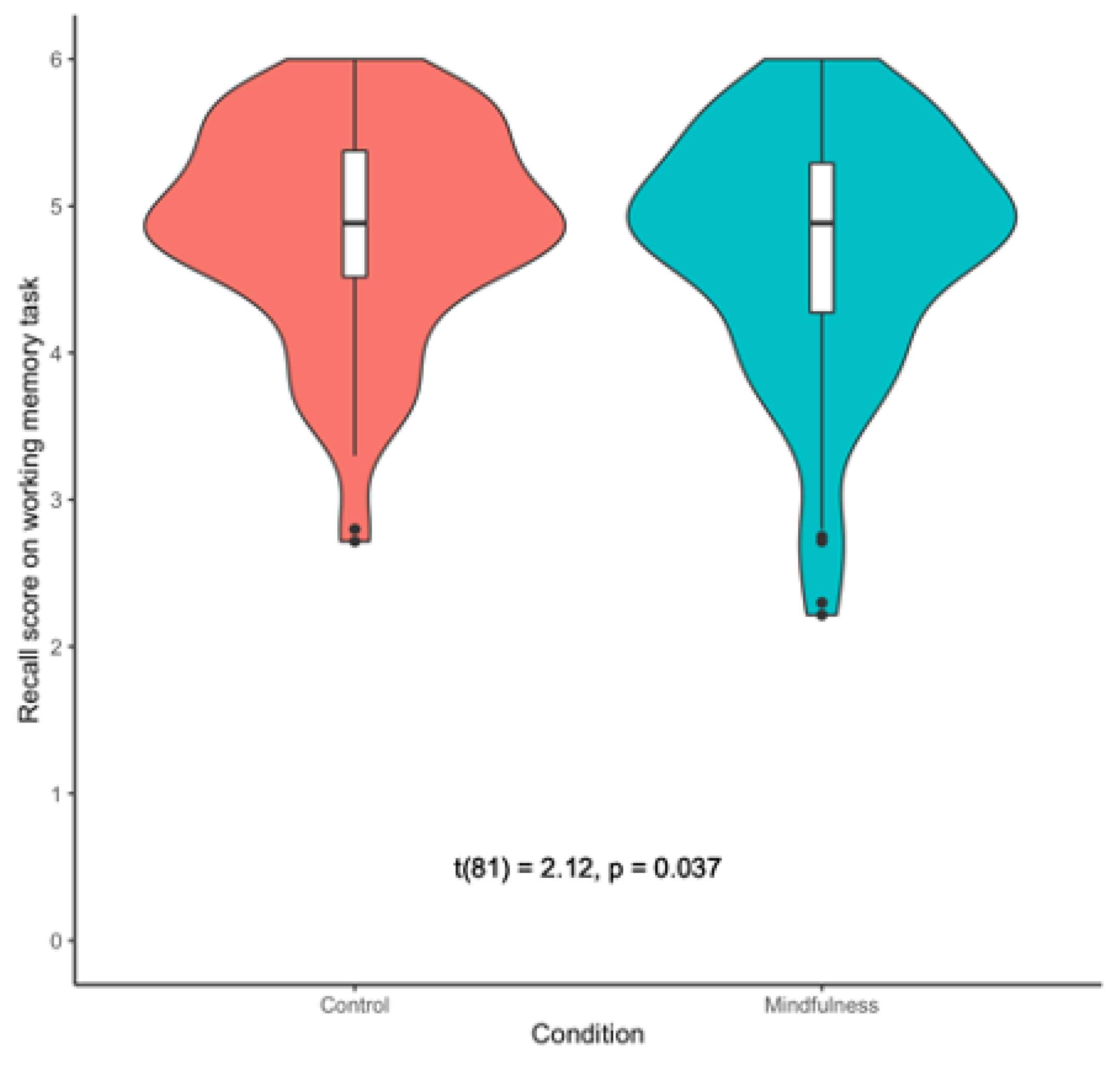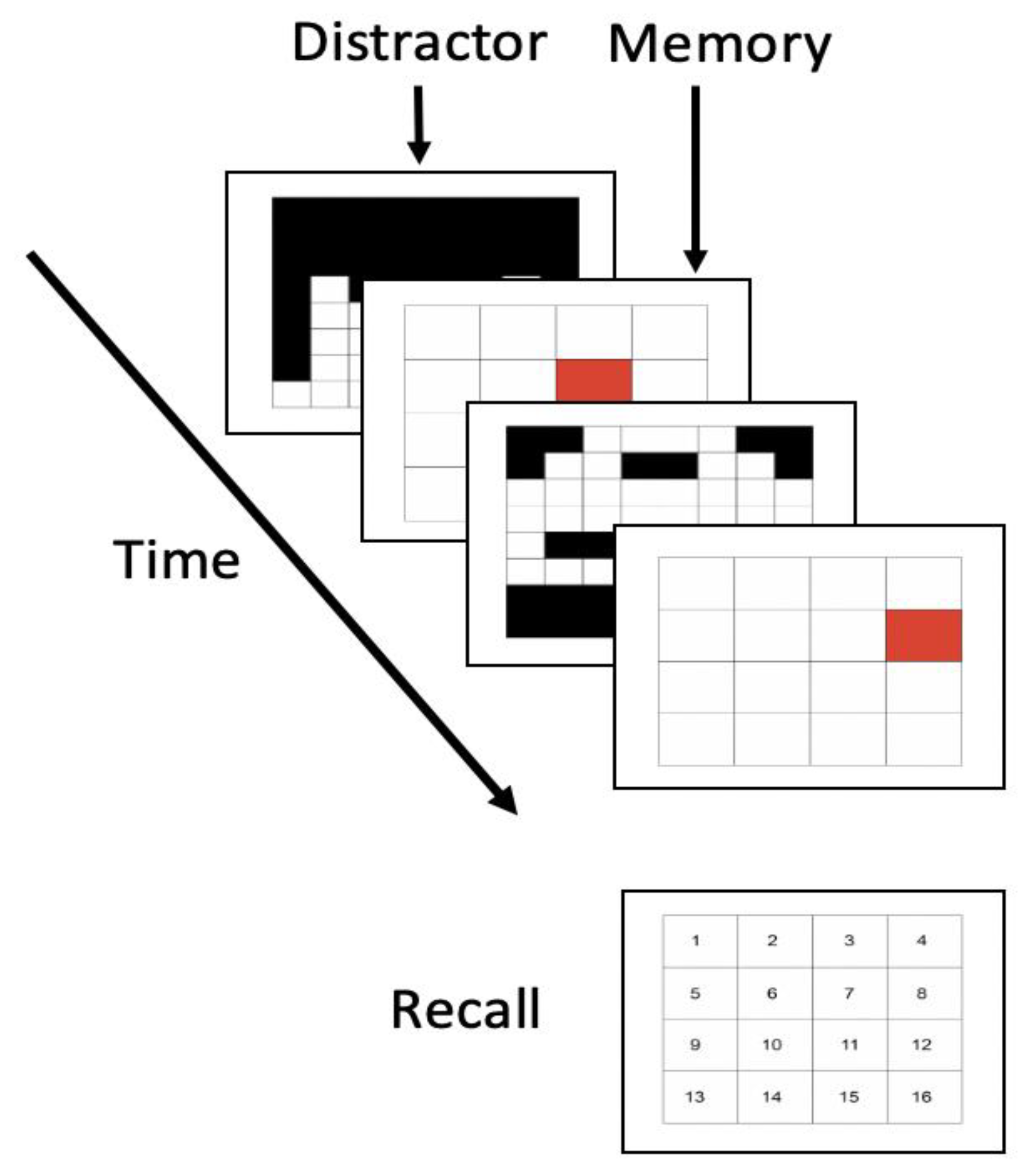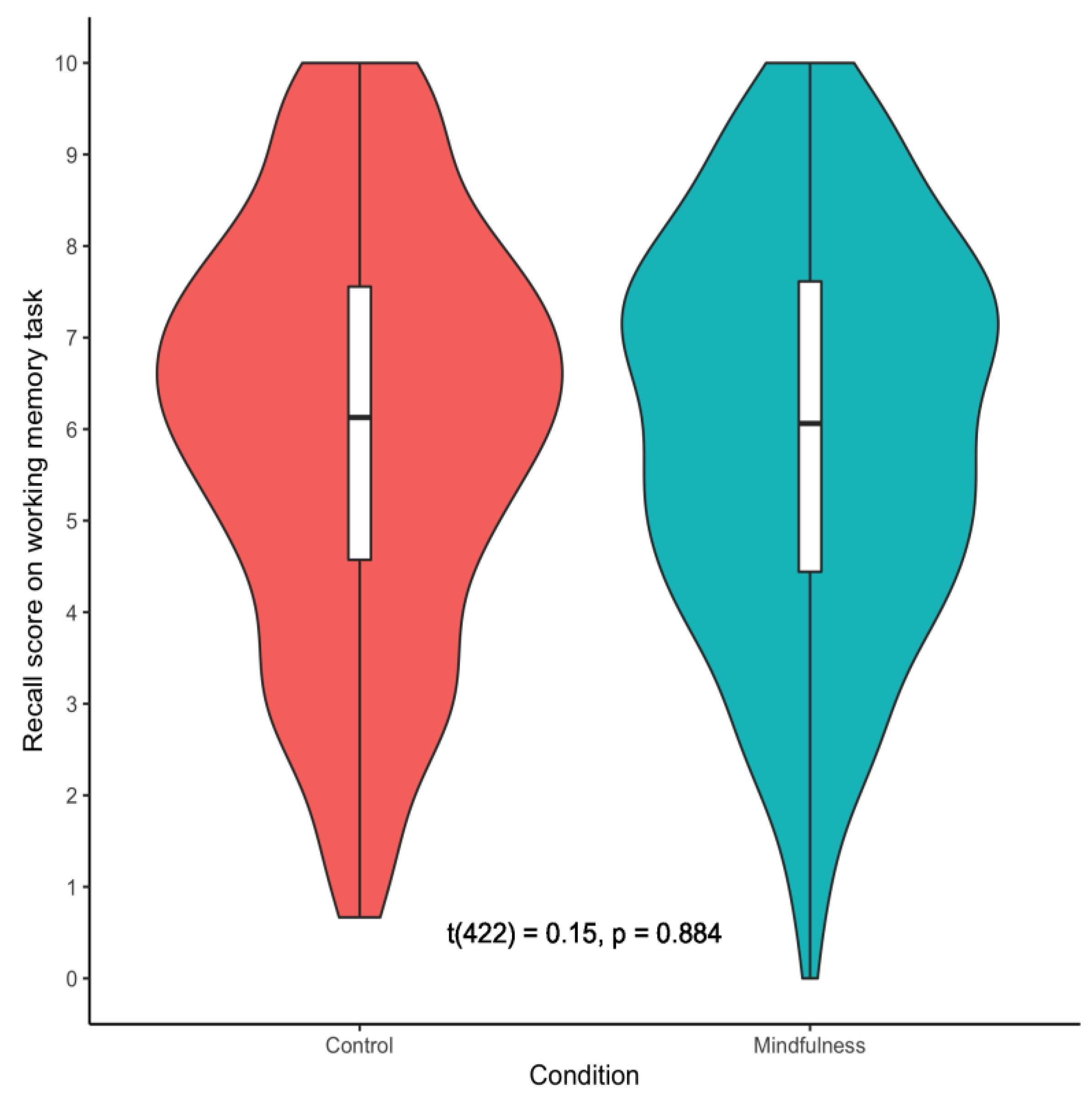Brief Mindfulness Breathing Exercises and Working Memory Capacity: Findings from Two Experimental Approaches
Abstract
1. Introduction
2. Study 1
2.1. Materials and Methods
2.1.1. Participants
2.1.2. Procedure
2.2. Results
2.2.1. Working Memory Capacity
2.2.2. Exploratory Outcomes
3. Study 2
3.1. Materials and Methods
3.1.1. Participants
3.1.2. Procedure
3.2. Results
3.2.1. Working Memory Capacity
3.2.2. Exploratory Outcomes
4. Discussion
5. Conclusions
Author Contributions
Funding
Institutional Review Board Statement
Informed Consent Statement
Data Availability Statement
Acknowledgments
Conflicts of Interest
References
- Bishop, S.R.; Lau, M.; Shapiro, S.; Carlson, L.; Anderson, N.D.; Carmody, J.; Segal, Z.V.; Abbey, S.; Speca, M.; Velting, D.; et al. Mindfulness: A proposed operational definition. Clin. Psychol. Sci. Pract. 2006, 11, 230–241. [Google Scholar] [CrossRef]
- Brown, K.W.; Ryan, R.M. Perils and promise in defining and measuring mindfulness: Observations from experience. Clin. Psychol. Sci. Pract. 2006, 11, 242–248. [Google Scholar] [CrossRef]
- Morrison, A.B.; Jha, A.P. Mindfulness, attention, and working memory. In Handbook of Mindfulness and Self-Regulation; Ostafin, B.D., Robinson, M.D., Meier, B.P., Eds.; Springer: New York, NY, USA, 2015; pp. 33–45. ISBN 978-1-4939-2262-8. [Google Scholar]
- Jha, A.P.; Denkova, E.; Zanesco, A.P.; Witkin, J.E.; Rooks, J.; Rogers, S.L. Does mindfulness training help working memory ‘work’ better? Curr. Opin. Psychol. 2019, 28, 273–278. [Google Scholar] [CrossRef] [PubMed]
- Gothe, N.P.; Keswani, R.K.; McAuley, E. Yoga practice improves executive function by attenuating stress levels. Biol. Psychol. 2016, 121, 109–116. [Google Scholar] [CrossRef]
- Hartanto, A.; Yang, H. Testing theoretical assumptions underlying the relation between anxiety, mind wandering, and task-switching: A diffusion model analysis. Emotion 2020. [Google Scholar] [CrossRef]
- Moran, T.P. Anxiety and working memory capacity: A meta-analysis and narrative review. Psychol. Bull. 2016, 142, 831–864. [Google Scholar] [CrossRef]
- Chan, D.; Woollacott, M. Effects of level of meditation experience on attentional focus: Is the efficiency of executive or orientation networks improved? J. Alern. Complement. Med. 2007, 13, 651–658. [Google Scholar] [CrossRef]
- Chambers, R.; Lo, B.C.Y.; Allen, N.B. The impact of intensive mindfulness training on attentional control, cognitive style, and affect. Cogn. Ther. Res. 2008, 32, 303–322. [Google Scholar] [CrossRef]
- Heeren, A.; Van Broeck, N.; Philippot, P. The effects of mindfulness on executive processes and autobiographical memory specificity. Behav. Res. Ther. 2009, 47, 403–409. [Google Scholar] [CrossRef]
- Mallya, S.; Fiocco, A.J. Effects of mindfulness training on cognition and well-being in healthy older adults. Mindfulness 2016, 7, 453–465. [Google Scholar] [CrossRef]
- Wimmer, L.; Bellingrath, S.; von Stockhausen, L. Cognitive effects of mindfulness training: Results of a pilot study Based on a theory driven approach. Front. Psychol. 2016, 7, 1037. [Google Scholar] [CrossRef] [PubMed]
- Engle, R.W. Working memory capacity as executive attention. Curr. Direct. Psychol. Sci. 2002, 11, 19–23. [Google Scholar] [CrossRef]
- Friedman, N.P.; Miyake, A.; Corley, R.P.; Young, S.E.; DeFries, J.C.; Hewitt, J.K. Not all executive functions are related to intelligence. Psychol. Sci. 2006, 17, 172–179. [Google Scholar] [CrossRef] [PubMed]
- Kane, M.J.; Hambrick, D.Z.; Tuholski, S.W.; Wilhelm, O.; Payne, T.W.; Engle, R.W. The generality of working memory capacity: A latent-variable approach to verbal and visuospatial memory span and reasoning. J. Exp. Psychol. Gen. 2004, 133, 189–217. [Google Scholar] [CrossRef] [PubMed]
- Jha, A.P.; Stanley, E.A.; Kiyonaga, A.; Wong, L.; Gelfand, L. Examining the protective effects of mindfulness training on working memory capacity and affective experience. Emotion 2010, 10, 54–64. [Google Scholar] [CrossRef]
- Van Vugt, M.K.; Jha, A.P. Investigating the impact of mindfulness meditation training on working memory: A mathematical modeling approach. Cogn. Affect. Behav. Neurosci. 2011, 11, 344–353. [Google Scholar] [CrossRef]
- Bonamo, K.K.; Legerski, J.-P.; Thomas, K.B. The influence of a brief mindfulness exercise on encoding of novel words in female college students. Mindfulness 2015, 6, 535–544. [Google Scholar] [CrossRef]
- Quach, D.; Jastrowski Mano, K.E.; Alexander, K. A randomized controlled trial examining the effect of mindfulness meditation on working memory capacity in adolescents. J. Adolesc. Health 2016, 58, 489–496. [Google Scholar] [CrossRef]
- Hommel, B.; Colzato, L.S. Meditation and metacontrol. J. Cogn. Enhanc. 2017, 1, 115–121. [Google Scholar] [CrossRef]
- Clinton, V.; Swenseth, M.; Carlson, S.E. Do mindful breathing exercises benefit reading comprehension? A Brief Report. J. Cogn. Enhanc. 2018, 2, 305–310. [Google Scholar] [CrossRef]
- Mrazek, M.D.; Smallwood, J.; Schooler, J.W. Mindfulness and mind-wandering: Finding convergence through opposing constructs. Emotion 2012, 12, 442–448. [Google Scholar] [CrossRef] [PubMed]
- Hafenbrack, A.C.; Kinias, Z.; Barsade, S.G. Debiasing the mind through meditation: Mindfulness and the sunk-cost bias. Psychol. Sci. 2014, 25, 369–376. [Google Scholar] [CrossRef] [PubMed]
- Arch, J.J.; Craske, M.G. Mechanisms of mindfulness: Emotion regulation following a focused breathing induction. Behav. Res. Ther. 2006, 44, 1849–1858. [Google Scholar] [CrossRef] [PubMed]
- Charness, G.; Gneezy, U.; Kuhn, M.A. Experimental methods: Between-subject and within-subject design. J. Econ. Behav. Organ. 2012, 81, 1–8. [Google Scholar] [CrossRef]
- Hartanto, A.; Ong, N.C.H.; Ng, W.Q.; Majeed, N.M. The effect of state gratitude on cognitive flexibility: A within-subject experimental approach. Brain Sci. 2020, 10, 413. [Google Scholar] [CrossRef]
- Adler, N.E.; Epel, E.S.; Castellazzo, G.; Ickovics, J.R. Relationship of subjective and objective social status with psychological and physiological functioning: Preliminary data in healthy, white women. Health Psychol. 2000, 19, 586–592. [Google Scholar] [CrossRef]
- Khoury, B.; Sharma, M.; Rush, S.E.; Fournier, C. Mindfulness-based stress reduction for healthy individuals: A meta-analysis. J. Psychosom. Res. 2015, 78, 519–528. [Google Scholar] [CrossRef]
- La Pointe, L.B.; Engle, R.W. Simple and complex word spans as measures of working memory capacity. J. Exp. Psychol. Learn. Mem. Cogn. 1990, 16, 1118–1133. [Google Scholar] [CrossRef]
- Schmader, T.; Johns, M. Converging evidence that stereotype threat reduces working memory capacity. J. Pers. Soc. Psychol. 2003, 85, 440–452. [Google Scholar] [CrossRef]
- Balota, D.A.; Yap, M.J.; Hutchison, K.A.; Cortese, M.J.; Kessler, B.; Loftis, B.; Neely, J.H.; Nelson, D.L.; Simpson, G.B.; Treiman, R. The english lexicon project. Behav. Res. Methods 2007, 39, 445–459. [Google Scholar] [CrossRef]
- Conway, A.R.A.; Kane, M.J.; Bunting, M.F.; Hambrick, D.Z.; Wilhelm, O.; Engle, R.W. Working memory span tasks: A methodological review and user’s guide. Psychon. Bull. Rev. 2005, 12, 769–786. [Google Scholar] [CrossRef] [PubMed]
- R Core Team. R: A Language and Environment for Statistical Computing; R Foundation for Statistical Computing: Vienna, Austria, 2020. [Google Scholar]
- Morey, R.D.; Rouder, J.N. Bayes factor approaches for testing interval null hypotheses. Psychol. Methods 2011, 16, 406–419. [Google Scholar] [CrossRef] [PubMed]
- Becker, B.J. Synthesizing standardized mean-change measures. Br. J. Math. Stat. Psychol. 1988, 41, 257–278. [Google Scholar] [CrossRef]
- Unsworth, N.; Heitz, R.P.; Schrock, J.C.; Engle, R.W. An automated version of the operation span task. Behav. Res. Methods 2005, 37, 498–505. [Google Scholar] [CrossRef]
- Foster, J.L.; Shipstead, Z.; Harrison, T.L.; Hicks, K.L.; Redick, T.S.; Engle, R.W. Shortened complex span tasks can reliably measure working memory capacity. Mem. Cognit. 2015, 43, 226–236. [Google Scholar] [CrossRef]
- Cohen, J. Statistical Power Analysis for the Behavioral Sciences, 2nd ed.; Routledge: New York, NY, USA, 1988; ISBN 978-0-203-77158-7. [Google Scholar]
- Mrazek, M.D.; Franklin, M.S.; Phillips, D.T.; Baird, B.; Schooler, J.W. Mindfulness training improves working memory capacity and GRE performance while reducing mind wandering. Psychol. Sci. 2013, 24, 776–781. [Google Scholar] [CrossRef]
- Roeser, R.W.; Schonert-Reichl, K.A.; Jha, A.; Cullen, M.; Wallace, L.; Wilensky, R.; Oberle, E.; Thomson, K.; Taylor, C.; Harrison, J. Mindfulness training and reductions in teacher stress and burnout: Results from two randomized, waitlist-control field trials. J. Educ. Psychol. 2013, 105, 787–804. [Google Scholar] [CrossRef]
- Basso, J.C.; McHale, A.; Ende, V.; Oberlin, D.J.; Suzuki, W.A. Brief, daily meditation enhances attention, memory, mood, and emotional regulation in non-experienced meditators. Behav. Brain Res. 2019, 356, 208–220. [Google Scholar] [CrossRef]
- Johnson, S.; Gur, R.M.; David, Z.; Currier, E. One-session mindfulness meditation: A randomized controlled study of effects on cognition and mood. Mindfulness 2015, 6, 88–98. [Google Scholar] [CrossRef]
- Zeidan, F.; Johnson, S.K.; Diamond, B.J.; David, Z.; Goolkasian, P. Mindfulness meditation improves cognition: Evidence of brief mental training. Conscious. Cogn. 2010, 19, 597–605. [Google Scholar] [CrossRef]
- Kirchner, W.K. Age differences in short-term retention of rapidly changing information. J. Exp. Psychol. 1958, 55, 352–358. [Google Scholar] [CrossRef] [PubMed]
- Strauss, E.; Sherman, E.M.S.; Spreen, O. A Compendium of Neuropsychological Tests: Administration, Norms, and Commentary; Oxford University Press: New York, NY, USA, 2006; ISBN 978-0-19-515957-8. [Google Scholar]
- Gallant, S.N. Mindfulness Meditation Practice and Executive Functioning: Breaking down the Benefit. Conscious. Cogn. 2016, 40, 116–130. [Google Scholar] [CrossRef]
- Hartanto, A.; Yong, J.C. Measurement Matters: Higher Waist-to-Hip Ratio but Not Body Mass Index Is Associated with Deficits in Executive Functions and Episodic Memory. PeerJ 2018, 6, e5624. [Google Scholar] [CrossRef]
- Friedman, N.P.; Miyake, A. The Relations Among Inhibition and Interference Control Functions: A Latent-Variable Analysis. J. Exp. Psychol. Gen. 2004, 133, 101–135. [Google Scholar] [CrossRef] [PubMed]
- Dandurand, F.; Shultz, T.R.; Onishi, K.H. Comparing online and lab methods in a problem-solving experiment. Behav. Res. Methods 2008, 40, 428–434. [Google Scholar] [CrossRef] [PubMed]
- Lam, K.; Seiden, D. Effects of a brief mindfulness curriculum on self-reported executive functioning and emotion regulation in hong kong adolescents. Mindfulness 2020, 11, 627–642. [Google Scholar] [CrossRef]




| Characteristic | N | M (SD) or % | Range |
|---|---|---|---|
| Sex (% female) | 82 | 71.95% | |
| Race (% Chinese) | 82 | 80.49% | |
| Age (years) | 81 | 21.02 (1.82) | 18–27 |
| Education 1 | 82 | 3.65 (0.78) | 3–5 |
| Household income 2 | 80 | 4.55 (2.30) | 1–9 |
| Personal income 3 | 82 | 1.79 (1.17) | 1–9 |
| Subjective socioeconomic status 4 | 82 | 6.27 (1.37) | 3–10 |
| Outcome | N | Mindfulness M (SD) | Control M (SD) | t | df | p | d |
|---|---|---|---|---|---|---|---|
| Working memory capacity | 82 | 4.71 (0.84) | 4.85 (0.72) | 2.12 | 81 | 0.037 | −0.19 |
| Stress | 82 | 2.58 (0.86) | 2.63 (0.79) | 0.57 | 81 | 0.570 | −0.06 |
| Mindfulness (N = 208) | Control (N = 216) | |||
|---|---|---|---|---|
| Characteristic | M (SD) | Range | M (SD) | Range |
| Sex (% female) | 56.25% | 57.41% | ||
| Race (% White) | 81.25% | 78.70% | ||
| Age (years) | 42.90 (13.45) | 19–73 | 44.58 (13.13) | 19–77 |
| Education 1 | 8.43 (2.08) | 3–12 | 8.45 (2.02) | 3–12 |
| Household income 2 | 2.82 (1.72) | 1–9 | 2.86 (1.92) | 1–9 |
| Personal income 3 | 6.06 (2.69) | 1–9 | 5.68 (2.74) | 1–9 |
| Subjective socioeconomic status 4 | 5.02 (1.72) | 1–10 | 5.10 (1.68) | 1–9 |
| Outcome | Mindfulness (N = 208) M (SD) | Control (N = 216) M (SD) | t | df | p | d |
|---|---|---|---|---|---|---|
| Working memory capacity | 5.98 (2.16) | 6.01 (2.22) | 0.15 | 422 | 0.884 | −0.01 |
| Absorption | 4.07 (1.19) | 3.83 (1.25) | −2.02 | 422 | 0.045 | 0.20 |
| Decrease in stress | 0.37 (0.71) | 0.21 (0.68) | 2.40 | 422 | 0.017 | 0.23 |
Publisher’s Note: MDPI stays neutral with regard to jurisdictional claims in published maps and institutional affiliations. |
© 2021 by the authors. Licensee MDPI, Basel, Switzerland. This article is an open access article distributed under the terms and conditions of the Creative Commons Attribution (CC BY) license (http://creativecommons.org/licenses/by/4.0/).
Share and Cite
Quek, F.Y.X.; Majeed, N.M.; Kothari, M.; Lua, V.Y.Q.; Ong, H.S.; Hartanto, A. Brief Mindfulness Breathing Exercises and Working Memory Capacity: Findings from Two Experimental Approaches. Brain Sci. 2021, 11, 175. https://doi.org/10.3390/brainsci11020175
Quek FYX, Majeed NM, Kothari M, Lua VYQ, Ong HS, Hartanto A. Brief Mindfulness Breathing Exercises and Working Memory Capacity: Findings from Two Experimental Approaches. Brain Sciences. 2021; 11(2):175. https://doi.org/10.3390/brainsci11020175
Chicago/Turabian StyleQuek, Frosch Y. X., Nadyanna M. Majeed, Meenakshi Kothari, Verity Y. Q. Lua, Hee Seng Ong, and Andree Hartanto. 2021. "Brief Mindfulness Breathing Exercises and Working Memory Capacity: Findings from Two Experimental Approaches" Brain Sciences 11, no. 2: 175. https://doi.org/10.3390/brainsci11020175
APA StyleQuek, F. Y. X., Majeed, N. M., Kothari, M., Lua, V. Y. Q., Ong, H. S., & Hartanto, A. (2021). Brief Mindfulness Breathing Exercises and Working Memory Capacity: Findings from Two Experimental Approaches. Brain Sciences, 11(2), 175. https://doi.org/10.3390/brainsci11020175






